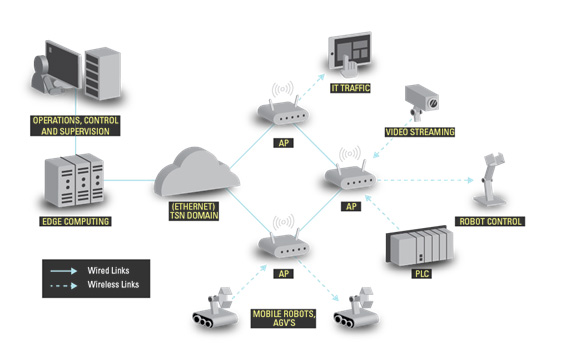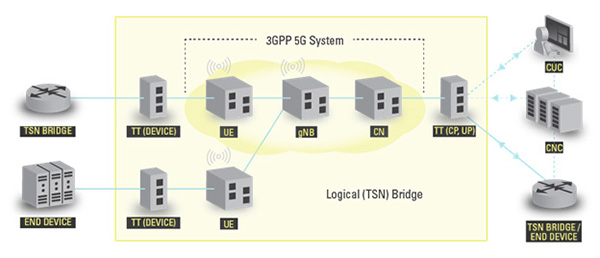Bringing IEEE TSN standards to 5G applications
Alon Regev, Keysight Technologies and Stephen F. Bush, GE Global Research Center, discuss the benefits, challenges, and opportunities.
The last few years have seen the implementation of Time Sensitive Networking (TSN), a family of IEEE 802.1 standards enabling time synchronisation and data delivery with strict latency bounds, grow steadily in Ethernet-based wired networks. As TSN continues to become more widely implemented in Industrial Internet of Things (IIoT) applications, the next natural step for the industry is to extend TSN over advancing wireless technologies - and there is already substantial industry support.
With the benefits of wireless communication (such as greater flexibility, higher mobility and reconfigurability, and lower maintenance) becoming increasingly apparent, many are eager to extend these capabilities to advancing wireless technologies, like WiFi 6 and 5G. For example, for manufacturers of end devices and systems across IIoT, wireless will enable them to easily reconfigure industrial automation, control systems, factory automation, and other elements of Industry 4.0. However, while wireless TSN, WiFi 6, and 5G will certainly transform the future of wireless networks for the better with high reliability, resiliency, and security, the transition will not be immediate - and there will be some challenges to securing standards development and adoption. Avnu Alliance members Keysight Technologies and GE discuss the benefits, challenges, and opportunities for 5G and other wireless applications.
The benefits of TSN for wireless standards
There are many markets that will benefit from extending TSN capabilities over wireless, but the industrial segment is one that has already received considerable interest from the TSN community. Mobile robots, for example, is one industrial use case for which wireless will prove beneficial, as wireless is fundamental for mobile’s requirements for greater flexibility and reconfigurability of tasks. The latency and reliability requirements for mobile robots are also compatible with capabilities of the latest wireless technologies.
Moving forward, as TSN features continue to extend to wireless over time, we can expect a diverse range of future use cases that benefit from wireless TSN. For instance, professional audio and video applications will also benefit from wireless connectivity and wireless TSN features, as avoiding high latency and jitter is paramount for providing a quality user experience.

Above: Wireless use cases in industrial
Wireless also offers unique benefits for automotive and transportation applications. The wiring harnesses in vehicles, aeroplanes, and trains adds high costs to production, however, if wireless technologies could provide the same time-sensitive performance as these harnesses, then production costs could be significantly reduced. Today, the automotive and transportation industries have specific safety critical requirements that are beyond the current scope of the wireless standards in 802.11 and 5G, but the opportunities exist for future improvement.
The movement to extend TSN capabilities over wireless is already underway, as there are some existing TSN standards and capabilities that have been extended to operate over wireless, 802.11 (WiFi) and 5G standards, for example, time synchronisation (802.1AS).
Time synchronisation is a fundamental TSN capability and is used by TSN-enabled applications and to enable other TSN capabilities, e.g., time aware scheduling. The standard extensions to distribute time over WiFi and 5G systems have been developed, enabling a single reference time that can be distributed between wired (Ethernet) and wireless TSN domains. Another fundamental capability of TSN is the ability to identify and differentiate time-sensitive traffic streams. With the IEEE 802.1Q-2014 update, mechanisms are defined to classify time-sensitive streams and differentiate them from other traffic across the TSN-enabled nodes and end stations.
With time synchronisation and traffic classification, shaping, and scheduling over WiFi 6 and 5G, it’s proven that some standards have already been successfully developed to extend TSN capabilities over wireless domains. However, it’s worth noting that the complete transition will be gradual, as the industry will have to adopt and deploy more wireless capabilities within TSN domains steadily over time.
Challenges and opportunities
In this continuing charge forward to extend TSN capabilities over wireless, the industry must be prepared to face challenges. For example, while we can expect that future TSN domains will be extended with both IEEE 802.11 and 3GPP-based wireless solutions, we will need to define a common model with clear service requirements and capabilities to integrate wireless technologies with a TSN domain in order to continue leveraging existing TSN standards and ecosystems in the future.
Additionally, we will have to consider ongoing configuration and management of TSN features, as well as the capabilities of underlying communication tasks, e.g., the CNC (Central Network Configuration) task that defines and configures a time-aware schedule for a set of time-sensitive streams across the network. The CNC task assumes a constant data rate for each Ethernet link in order to compute the proper gate operation schedule across the bridges. Therefore, we need to consider what will happen when wireless links are introduced, as the CNC will need to consider the possibility of dynamic changes in link speed/bandwidth due to wireless channel dynamics, interference, etc.

Above: 5G architecture for TSN time synchronisation integration
Interference (typically the number one concern for wireless TSN extensions) is another area that will need to be addressed, as the industry will need tools to mitigate the potential impact of interference in a wireless TSN domain. Because TSN is based on Ethernet and wireless standards (IEEE 802.11/WiFi and 5G), networks can leverage the security best practices and standards that have already been developed for Ethernet, 802.11, and 3GPP systems. Finally, though not yet realised, we should be cognisant of impending challenges with mobility and roaming. While mobility enables flexible deployment and easy recognition of devices and applications, the current roaming procedures in cellular and WiFi networks are unable to meet the stringent latency and high reliability requirements in TSN domains. Thus, for future wireless connectivity standards, it will be important to provide TSN-grade latency and packet loss performance during roaming.
Despite these challenges, the benefits of extending TSN capabilities over wireless make the task a worthwhile endeavour - and there is already work underway to introduce TSN support over 5G. For instance, while 5G is not a native 802 LAN technology and, thus, cannot be directly integrated with Ethernet TSN standards at Layer 2, the 3GPP Rel-16 has started to introduce TSN support over 5G. This 3GPP approach to integration is over-the-top (i.e., TSN-related functionality is confined to TSN Translator (TT) functions at the 5G system ingress and egress points), but more work is expected to continue in the 3GPP Rel.17 specification.
Conclusion
As the need for time-synchronised communications continues to grow and the TSN community evolves, it will be important to seek a deeper understanding of how wireless networks can schedule time sensitive traffic. As the need for time-synchronised communications continues to grow, the Avnu Alliance and its Wireless TSN Working Group remain committed to accelerating the adoption of the TSN interoperable foundation with extensions over wireless technologies to ensure maximum benefits for the industry.










